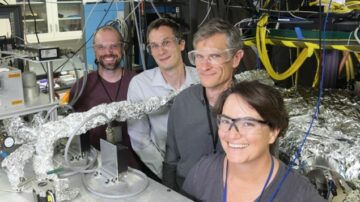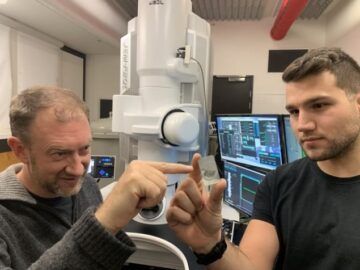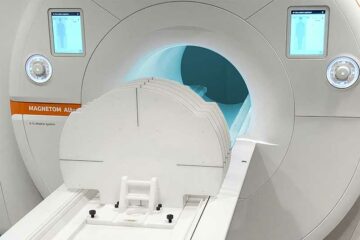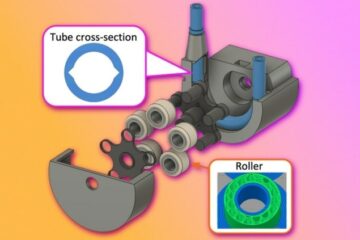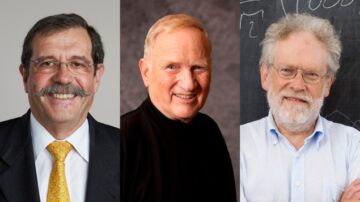
Physics for patients, physics for health, physics for good: that’s the high-level career opportunity that awaits students heading to the University of Oxford, UK, this September to take up their places on the newly launched MSc in Medical Physics with Radiobiology. This one-year, full-time master’s programme is tailored for graduate scientists intent on pursuing a professional pathway in medical physics – from a clinical or academic research perspective – as well as related roles that require an in-depth understanding of medical physics (radiation protection and security, for example, or product development and engineering functions within the specialist technology companies serving the medical imaging and radiotherapy communities).
Launching with an initial cohort of 15 students for the 2023/24 academic year, the MSc is a collaboration between the University of Oxford’s Department of Oncology and the Department of Medical Physics and Clinical Engineering at Oxford University Hospitals (OUH) NHS Foundation Trust. The academic cycle being what it is, applications are already open for the 2024/25 academic year (starting September 2024) from candidates who hold, or are predicted to achieve, a first-class or strong upper-second-class undergraduate degree with honours in physics or a closely related subject.

“Our teaching priority is to elaborate on how ionizing and non-ionizing radiation are used in clinical practice, both in the context of radiotherapy and medical imaging,” explains Daniel McGowan, academic and clinical lead for the MSc (as well as Head of Education and Research in the OUH Department of Medical Physics and Clinical Engineering). That focus on radiation physics is reinforced by dedicated teaching modules on the fundamental principles of radiobiology to give graduate students a granular understanding of the effects of radiation at the molecular and cellular level (for example, how radiation induces DNA damage and how that feeds through into advanced treatment modalities in radiation oncology).
“We’re trying to differentiate this MSc versus other medical physics courses by addressing gaps in the learning market,” adds McGowan. “So, while radiobiology is front-and-centre, we’re also putting significant emphasis on a range of other hot topics that early-career medical physicists increasingly need to understand – from the design of clinical studies, for example, to the clinical impact of machine learning in cancer diagnosis and treatment planning for radiotherapy.”
No shortage of options
Another focus for McGowan and his teaching colleagues is to showcase the diversity of career pathways available to graduates pursuing combined studies in medical physics and radiobiology.
One way to help students figure out their next steps is the extensive guest speaker programme within the department of oncology – whether that’s a clinical physicist talking about the implementation of MR-guided radiotherapy in a hospital setting or an R&D scientist from industry specializing in imaging software. “The flexibility afforded by our MSc is key,” he explains. “As such, we encourage students to maintain an open mind about their long-term career choices.”
By extension, choice and flexibility are hard-wired into the MSc research project and dissertation – a piece of work that’s undertaken after students complete their six months of MSc taught-course modules. The 2023/24 cohort will have a long list of research projects to choose from, including experimental studies in FLASH radiotherapy (to elucidate how radiation delivered at ultrahigh dose rates can drastically reduce collateral damage and toxicity in normal healthy tissue while preserving anti-tumour activity); patient safety and QA in MR-guided radiotherapy (in which an MR-Linac configuration allows clinicians to see what they treat in real-time and adapt radiation delivery accordingly); as well as investigations into the use of virtual reality for improving the patient experience.
Wanted: multidisciplinary physicists
Other project options include the provision of targeted R&D support to industry partners – for example, on the testing and optimization of advanced imaging algorithms for PET or MRI systems – or collaboration with government scientists specializing in radiation protection, safety and regulation at the nearby Harwell campus of the UK Health Security Agency (UKHSA).

Alongside the twin-track focus on medical physics and radiobiology, another differentiator of the new MSc course is the opportunity it affords students to learn directly from clinical physicists working at the sharp-end of diagnosis and treatment in a hospital setting at OUH. “What we’re focused on is the inherent interdisciplinarity spanning physics, biology and medicine,” notes Tom Whyntie, a teaching fellow in the Department of Oncology with responsibility for MSc student learning and development.
Whyntie himself took a somewhat convoluted route into medical physics, having completed a PhD in dark-matter research at CERN’s Large Hadron Collider (LHC). “Given my background, I recognize the importance of blue-sky physics that’s driven, for the most part, by intellectual curiosity,” he explains. “What blows me away about my current research – developing novel pulse sequences for MR-guided radiotherapy – is seeing the direct impact of the work on treatment outcomes and patient care. This is physics in action – that straight line between research lab, clinical translation and at-scale clinical application.”
- The Institute of Physics and Engineering in Medicine (IPEM) accredits master’s programmes in medical physics and biomedical engineering in the UK. Given that it is a new course for the 2023/24 academic year, the University of Oxford’s MSc in Medical Physics with Radiobiology has provisional accreditation status from IPEM. The course will be subject to further inspection for full accreditation once the first cohort of students completes the taught-course and research modules in autumn 2024, with the initial cohort and subsequent student intakes receiving the IPEM-accredited degree qualification.
Pushing the boundaries in radiation oncology

Nathalie Lövgren is a medical physics student undertaking a DPhil in oncology at the University of Oxford. Here she tells Physics World about her research experience to date and the learning opportunities for graduate students considering MSc or doctoral studies within the department.
What’s the focus of your DPhil work?
I’m a member of Kristoffer Petersson’s multidisciplinary team investigating the biological mechanisms underpinning FLASH radiotherapy and optimal ways to implement the technique in clinical practice. My DPhil work focuses on clinical translation: evaluating the feasibility of deploying FLASH proton therapy into clinical practice and how the FLASH effect (normal tissue-sparing) can be accounted for in the treatment planning system.
How important is collaboration to you as an early-career scientist?
It’s fundamental – and essential. The Department of Oncology is a cosmopolitan research environment, with visiting doctoral students from other UK and EU institutions conducting their research with us in Oxford, either coming for weeks or months at a time. For me personally, that means exposure to diverse research backgrounds, cross-fertilization of ideas, and an opportunity to build up a network across the medical physics and oncology communities.
What about opportunities for learning and development beyond your core research?
We’re encouraged to push the boundaries in terms of our broader skills development, prioritizing opportunities that will be useful to us down the line in our research careers. A case in point: I’ve just enrolled on a seven-month online Python course – Training in Data Science and Machine Learning for Health, Disease and Bioscience – at University College London. The course coverage forms a great base for a wide range of programming or machine-learning-based projects in the future. Outreach and engagement are also key. I’ve presented my research at several international conferences so far and, in the process, have initiated valuable contacts and collaborations with other early-career scientists as well as radiotherapy equipment vendors.
- SEO Powered Content & PR Distribution. Get Amplified Today.
- PlatoData.Network Vertical Generative Ai. Empower Yourself. Access Here.
- PlatoAiStream. Web3 Intelligence. Knowledge Amplified. Access Here.
- PlatoESG. Automotive / EVs, Carbon, CleanTech, Energy, Environment, Solar, Waste Management. Access Here.
- PlatoHealth. Biotech and Clinical Trials Intelligence. Access Here.
- ChartPrime. Elevate your Trading Game with ChartPrime. Access Here.
- BlockOffsets. Modernizing Environmental Offset Ownership. Access Here.
- Source: https://physicsworld.com/a/where-radiation-physics-meets-radiobiology-opening-up-diverse-career-paths-for-students/
- :has
- :is
- :where
- $UP
- 15%
- 2024
- a
- About
- above
- AC
- academic
- academic research
- accordingly
- accounted
- accreditation
- Achieve
- across
- Action
- activity
- adapt
- addressing
- Adds
- advanced
- afforded
- After
- algorithms
- allows
- already
- also
- an
- and
- Another
- Application
- applications
- ARE
- AS
- At
- available
- away
- background
- backgrounds
- base
- BE
- being
- between
- Beyond
- biology
- biomedical
- both
- boundaries
- broader
- build
- by
- Campus
- CAN
- Cancer
- candidates
- care
- Career
- careers
- case
- cellular
- choice
- choices
- Choose
- click
- Clinical
- clinicians
- closely
- Cohort
- collaboration
- collaborations
- Collateral
- colleagues
- College
- combined
- coming
- Communities
- Companies
- complete
- Completed
- Completes
- conducting
- conferences
- Configuration
- considering
- contacts
- context
- Core
- course
- courses
- coverage
- curiosity
- Current
- cycle
- damage
- Daniel
- data
- data science
- Date
- dedicated
- Degree
- delivered
- delivery
- demonstrates
- Department
- deploying
- Design
- developing
- Development
- diagnosis
- differentiate
- differentiator
- direct
- directly
- Disease
- diverse
- Diversity
- dna
- dose
- down
- drastically
- driven
- during
- Education
- effect
- effects
- either
- Elaborate
- emphasis
- encourage
- encouraged
- engagement
- Engineering
- enrolled
- Environment
- equipment
- essential
- EU
- evaluating
- example
- experience
- experimental
- Explains
- Exposure
- extension
- extensive
- far
- fellow
- Figure
- First
- Flash
- Flexibility
- Focus
- focused
- focuses
- For
- forms
- Foundation
- from
- full
- functions
- fundamental
- further
- future
- gaps
- Give
- given
- good
- Government
- graduate
- great
- Guest
- Have
- having
- he
- head
- Heading
- Health
- healthy
- help
- her
- here
- high-level
- his
- hold
- Home
- Hospital
- hospitals
- HOT
- How
- HTTPS
- i
- ideas
- image
- Imaging
- Impact
- implement
- implementation
- importance
- important
- improving
- in
- in-depth
- include
- Including
- increasingly
- industry
- industry partners
- information
- inherent
- initial
- initiated
- institutions
- intellectual
- intent
- International
- into
- investigating
- Investigations
- issue
- IT
- John
- jpg
- just
- Key
- lab
- large
- launched
- lead
- LEARN
- learning
- Level
- Line
- List
- London
- Long
- long-term
- machine
- machine learning
- maintain
- Market
- master’s
- max-width
- me
- means
- mechanisms
- medical
- medical imaging
- Medical physics
- medicine
- Meets
- member
- mind
- modalities
- Modules
- molecular
- Month
- months
- most
- MRI
- multidisciplinary
- my
- Need
- network
- New
- newly
- next
- NHS
- normal
- Notes
- novel
- now
- of
- on
- once
- oncology
- online
- open
- opening
- opportunities
- Opportunity
- optimal
- optimization
- Options
- or
- Other
- our
- out
- outcomes
- outreach
- Oxford
- oxford university
- part
- partners
- pathway
- pathways
- patient
- patient care
- patients
- Personally
- perspective
- phd
- Physics
- Physics World
- piece
- pipeline
- Places
- planning
- plato
- Plato Data Intelligence
- PlatoData
- Point
- practice
- predicted
- presented
- preserving
- principles
- prioritizing
- priority
- process
- Product
- product development
- professional
- programme
- programmes
- Programming
- project
- projects
- protection
- provision
- provisional
- pulse
- Push
- Putting
- Python
- Q&A
- qualification
- R&D
- Radiation
- Radiotherapy
- range
- Rates
- real-time
- Reality
- receiving
- recognize
- reduce
- Regulation
- related
- require
- research
- responsibility
- roles
- Route
- Safety
- Science
- Scientist
- scientists
- security
- see
- seeing
- September
- serving
- setting
- several
- she
- shortage
- showcase
- significant
- SIX
- Six months
- skills
- So
- so Far
- Software
- somewhat
- spanning
- Speaker
- specialist
- specializing
- Sponsored
- Starting
- Status
- Steps
- straight
- strong
- Student
- Students
- studies
- subject
- subsequent
- such
- support
- system
- Systems
- tailored
- Take
- Talent
- talking
- targeted
- Teaching
- Technology
- technology companies
- tells
- terms
- Testing
- that
- The
- The Future
- the UK
- their
- therapy
- they
- this
- Through
- thumbnail
- time
- tissue
- to
- tom
- took
- Topics
- Training
- Translation
- treat
- treatment
- Trust
- trying
- Uk
- under
- underpinning
- understand
- understanding
- university
- University of Oxford
- us
- use
- used
- Valuable
- vendors
- Versus
- Virtual
- Virtual reality
- Visit
- Way..
- ways
- we
- Weeks
- WELL
- What
- whether
- which
- while
- WHO
- wide
- Wide range
- will
- with
- within
- Work
- working
- world
- year
- you
- Your
- zephyrnet


